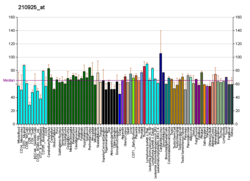CIITA is a human gene which encodes a protein called the class II, major histocompatibility complex, transactivator.[5] Mutations in this gene are responsible for the bare lymphocyte syndrome in which the immune system is severely compromised and cannot effectively fight infection.[5] Chromosomal rearrangement of CIITA is involved in the pathogenesis of Hodgkin lymphoma and primary mediastinal B cell lymphoma.[6]
Function
CIITA mRNA can only be detected in human leukocyte antigen (HLA) system class II-positive cell lines and tissues. This highly restricted tissue distribution suggests that expression of HLA class II genes is to a large extent under the control of CIITA.[7] However, CIITA does not appear to directly bind to DNA.[7] Instead CIITA functions through activation of the transcription factor RFX5.[8] Hence CIITA is classified as a transcriptional coactivator.
The CIITA protein contains an acidic transcriptional activation domain, 4 LRRs (leucine-rich repeats) and a GTP binding domain.[9] The protein uses GTP binding to facilitate its own transport into the nucleus.[10] Once in the nucleus, the protein acts as a positive regulator of class II major histocompatibility complex gene transcription, and is often referred to as the "master control factor" for the expression of these genes.[11][12]
CIITA expression is induced by interferon gamma, possibly assisted by other signals.[13] MHC II expression in intestinal epithelial cells is upregulated under inflammation.[13]
Interactions
CIITA has been shown to interact with:
See also
References
External links
Wikiwand in your browser!
Seamless Wikipedia browsing. On steroids.
Every time you click a link to Wikipedia, Wiktionary or Wikiquote in your browser's search results, it will show the modern Wikiwand interface.
Wikiwand extension is a five stars, simple, with minimum permission required to keep your browsing private, safe and transparent.






